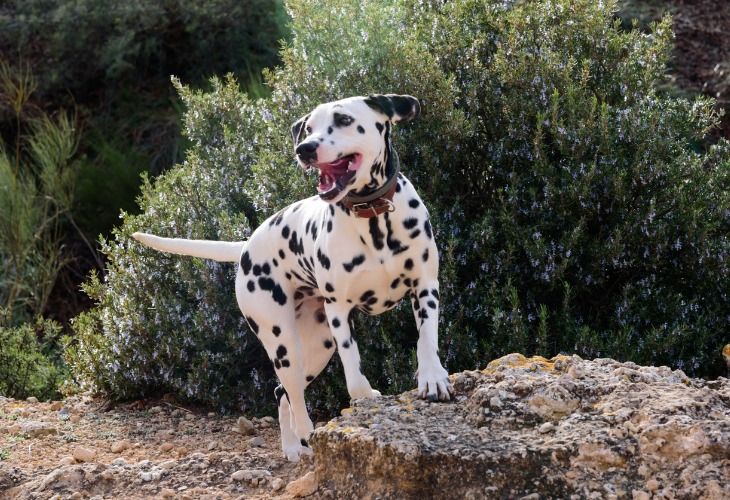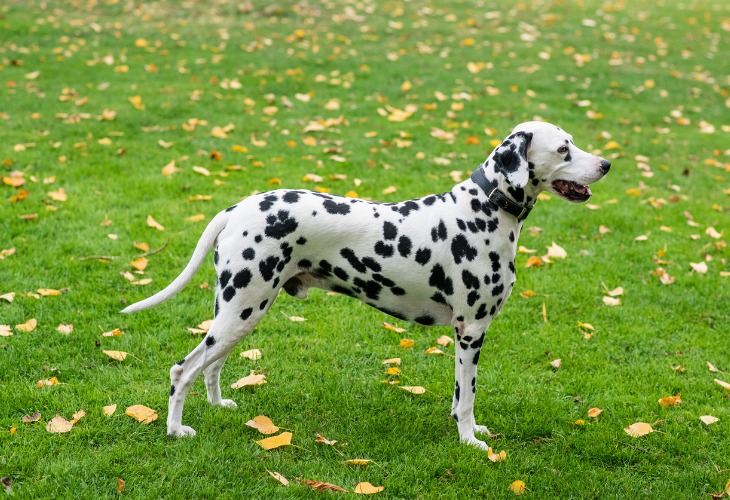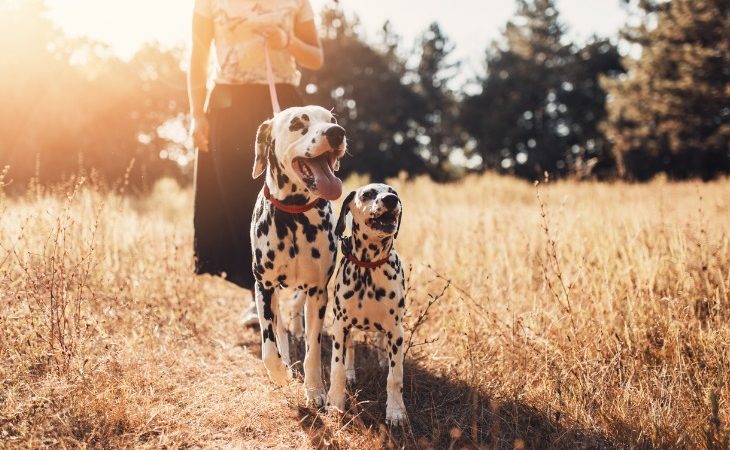Kennel club standards: Croatian Kennel Club, FCI | Size: Medium | Life expectancy: 10+ years | Training: Difficult | Coat: Short | Origin: Croatia, uncertain
The Dalmatian is a popular dog breed. Medium to large in size, it is famous for its white coat and dark spots.
Origins of the Dalmatian
Unclear origins
The exact origins of the Dalmatian remain uncertain and even controversial. For example, Ancient Egyptian low reliefs show spotted dogs. However, the ancestors of the Dalmatian are also depicted in Croatian religious paintings of the same period. The Dalmatian would thus be native to the Mediterranean basin. However, the physique and coat of the Dalmatian are reminiscent of the Great Dane breed, which originated in northern Europe. In addition, Flemish paintings from the 15th century show dogs resembling today’s Dalmatians.
It is thus quite difficult to determine the origin of the Dalmatian. Wherever its birthplace, representations of this dog attest that it was once a hunting dog.
A dog breed from Dalmatia?
It was not until 1771 that the naturalist Thomas Pennant described this dog for the first time in Synopsis of Quadrupeds. The breed was then named Dalmatian, in reference to the region of Dalmatia in Croatia since it was frequently painted there.
Although the Dalmatian was originally a hunting dog, its elegant appearance, beautiful coat and sturdiness captivated the British as early as the 1750s. The British adopted the Dalmatian as an escort dog to lead the way for carriages, inviting passersby and animals to move out of the way. The Dalmatian soon became associated with horses and stagecoaches and was nicknamed the “coach dog”.
The Dalmatian in popular culture : 101 Dalmatians and firefighting dogs
The Disney film 101 Dalmatians was the next big milestone in the history of the dog breed, marking the beginning of a deep infatuation with the four-legged friend in 1961. In this cartoon, Dalmatian puppies are pursued by the evil Cruella who wants to make a coat out of their fur. Since then, the popularity of the Dalmatian has regularly peaked and it remains one of the most popular breeds.
In the United States, this breed even became the mascot for firefighters. Dalmatians were seen as dependable in the past because they got along well with horses when fire engines were drawn by horses.The friendliness and intelligence of this dog also allows it to learn tricks and to join circuses and fairs to amuse the young and old.
The Dalmatian’s personality
Sensitive and affectionate, the Dalmatian is also a brave and strong headed dog.
The Dalmatian’s qualities
The Dalmatian has many qualities, such as intelligence. For example, it is easy to teach a Dalmatian new tricks. Active and energetic, the Dalmatian is a very dynamic breed that requires a lot of exercise. With that being said, the Dalmatian is a relatively calm dog and barks very little. The Dalmatian knows how to quietly keep his master company. This breed easily shows its affection and likes to stay permanently close to its family. Thanks to its friendly personality, the Dalmatian can live in harmony with other animals and with fellow Dalmatians.

Does the Dalmatian have any downsides?
Dalmatians have a strong character and require firm training with patience and dedication. This large dog needs a lot of exercise, requiring frequent outings. For this reason, it is difficult to get them used to life in an apartment.
The physical characteristics of the Dalmatian
General
This dog can be recognized from afar thanks to its white coat and black or brown colored spots. Medium to large in size, it has a short coat and a friendly demeanor.
Head
The head of the Dalmatian is shaped like a prism. The breed has a flat skull with a slight lateral curve. Its forehead is a slightly pronounced, its muzzle well developed and its nose is the same color as its spots (brown or black). The jaws of a Dalmatian are powerful with tight pigmented lips. The eyes have an oval shape and their color matches that of its spots. Its ears form isosceles triangles set high on the skull and held against the head. The tips of the ears are rounded and their surface is spotted.
Body
The Dalmatian has a muscular body that is shaped like a rectangle. The neck of this dog breed is long and its back is powerful and straight. The Dalmatian’s muscular loins are short. As for the tail of this dog breed, it elegantly prolongs the rear end.

The Dalmatian : coat, color, and grooming
The Dalmatian’s coat
All Dalmatians have a short, shiny and dense coat. Their coat is particularly unique.
The colors of the Dalmatian
There are two varieties of Dalmatians. The coat is white with round spots measuring 2 or 3 cm in diameter, which stand out well from the white background. The spots are spread symmetrically over the whole body and head of the animal. These spots can be either black or brown.
Grooming
Because of its short coat, this requires requires simple but frequent maintenance. Dalmatians shed a lot. Therefore, they should be brushed several times a week to remove dead hairs and impurities embedded in the coat.
Did you know?
In the 17th century, the Flemish painter Jan Fyt often depicted a Dalmatian in his paintings of hunting trips.
The American president George Washington is said to have been one of the first Dalmatian breeders in history. This was around the year 1780. He is said to have owned a Dalmatian nicknamed Madame Moose.
The Dalmatian at a glance
Size: between 56 and 61 cm (22 and 24 in) for males and between 54 and 59 cm (21 and 23 in) for females.
Weight: between 27 and 32 kg (59 and 70 lbs) for males and between 24 and 29 kg (52 and 64 lbs) for females.
Is the Dalmatian good with children? Yes, as long as the children respect the calmness of the Dalmatian.
Is the Dalmatian easy to train? This dog has a strong personality. It is advised to start its training very young. A lot of patience and kindness is necessary to train a Dalmatian well.

